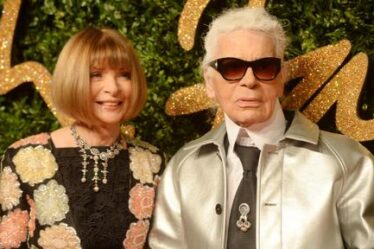
When Kenny Anderson joined Hugo Boss’s executive ranks, he gained access to a new tier of elite perks, which included spa treatments and a therapist.
“I felt like there was a huge weight on my shoulders to perform … support my team and deliver results,” he said. “The massages helped.”
The benefits didn’t just help Anderson feel more zen; they made him more productive too, he said. In a high-pressure merchandising role, the ability to shed stress helped him hit key milestones, like opening dozens of new stores in Mexico and Brazil.
Once associated mainly with outdoorsy brands like Patagonia and Nike, wellness has become a key element in corporate benefit packages at all sorts of companies. Luxury giants like LVMH, midsize fashion brands like Theory and beauty’s Glossier are among the firms offering some form of wellness programme.
These benefits can range from $25 gym stipends to all-expenses-paid mental wellness retreats. Hugo Boss’ Metzingen, Germany headquarters is tricked out with a fitness centre, physiotherapists, a doctor’s office and an in-house daycare. At Glossier’s home digs, there’s a stage for mental health talks — Deepak Chopra was one guest — and meditation sessions. On Running offers customisable self-care programmes and access to a network of coaches and counsellors, along with weekly “movement sessions” like group runs, yoga, and hiking. Alo Yoga offers free yoga classes and an on-site gym at its HQ.
How much employees actually use these programmes is less well documented. In fashion’s “always-on” culture, some employees think twice before taking their employers up on sabbaticals, yoga sessions, or a quick massage. That is, if they want to partake at all: membership at gyms in a distant part of town, or a clunky meditation app look good in recruitment campaigns but have limited appeal for workers.
To get the most out of their programmes, fashion firms must treat wellness like a “strategic tool” that can boost their profits — rather than a superficial perk, said Dilan Gomih, founder of Dilagence, a workplace wellbeing consultancy that counts Google and Pinterest among its clients.
“Companies have to remember that who shows up to work for them is a human,” Gomih said. “If they aren’t well, then they are not being their most productive.”
“Companies have to remember that who shows up to work for them is a human,” Gomih said.
A Wellness Campaign
Generally, brands can label any programme — beyond standard health insurance or government-backed provisions like transportation accounts — as wellness if they can claim it supports employees’ mental and physical health. Employers pick from a staggering array of options, from discounts and cash stipends for counselling services, to nutrition guides, meditation apps, gym memberships and free spa access.
To get a return on their investment, fashion firms need to approach their wellness benefits packages the same way they build their brands: research the target audience, tailor packages to their needs, track success and stay updated on the latest innovations.
What made Hugo Boss’ programme useful for Anderson was that it took into account the demands he would face as an executive steering a global team. The tools were meant to help him cope with the stress (for his own health) but also make him better at his job (boosting the company’s bottom line).
It’s not uncommon for executives like Anderson to have access to a more premium tier of benefits. But companies should apply the same rigour and thoughtfulness to programmes offered to those on the lower rungs, including retail workers, said Paula Reid, an executive coach and president of the executive search firm Reid & Co.
“Top executives have the financial resources and cachet in the company to deal with things like child care [emergencies] or ageing parents,” she said. “But the bulk of an organisation is dealing with those same things on a day to day basis, without the resources to do it.”
Companies might consider offering a range of options or monetary stipends, letting employees define wellness on their own terms rather than pushing a specific fitness app, or meditation tool that could require them to adopt new habits, Gomih said.
Since wellness is not rigidly defined, some companies are broadening the scope to include services like childcare — now a growing focus in national conversation over mental health. In August, the US Surgeon General issued an advisory on parents’ mental health and well-being, calling for “a shift in culture, policies, and programmes to ensure all parents and caregivers can thrive.”
In 2021, Theory’s employees were excited when it began offering a $1000 monthly child care stipend that parents could use for expenses like daycare, in-home care and sitters, said Lisa Hollister, VP of talent acquisition and HR strategy at executive search firm Talent Suede, who managed executive recruiting at Theory during that time.
“It was really customised wellness,” she said. “We had a really great reaction to it — employees got engaged and had more questions.”
Based on feedback, the brand fine tuned the programme, expanding the age range for eligible children and allowing new employees to access benefits sooner, Hollister said.
Companies should track wellness programme usage rates and collect employee feedback through formal surveys, Gomih said. But, the clearest indications of a programme’s effectiveness — and any needed adjustments — often shows up in more subtle ways, like employee morale and whether people stay at the brand for the long haul.
“It’s more about listening to employees when they are in a meeting or when you’re hiring them [in the first place],” Hollister said. “Or when you have someone who’s poor-performing … or someone who’s leaving, what are some of the reasons behind that?”
“It’s more about listening to employees when they are in a meeting or when you’re hiring them [in the first place],” Hollister said.
Creating a Wellness Culture
Fashion companies must make it “culturally acceptable” for their employees to prioritise their wellbeing and actually use the tools they make available, Reid said. Otherwise brands will give the impression they’re only offering wellness for the optics — which can be more harmful than not having the perks in the first place.
“The values you espouse and the ones you have people live by — it’s imperative those two things align,” Reid said. “If they don’t, you can have the best wellness programme in the world, but your employees will be disturbed by the disconnect.”
Managers and senior executives are best positioned to model wellness-driven behaviour, experts say. At On Running’s Portland office, the company hosts a group lunch run or walk every Thursday. The brand’s CEO also makes it a point to break up his workday in Zurich, Switzerland with a daily run to reinforce the message that his workforce can and should do the same, On told BoF in an email.
“The reality is, even if employees hear that it’s okay to take a mental health day, they ultimately won’t, until they see their boss [do it],” Gomih said.
Companies should pay attention to and be transparent about their employees’ actual usage of perks like unlimited time off, sabbaticals and mental health days, she said.
As more companies make permanent decisions around the return to office, that’s likely to put a premium on one of the greatest wellness kickbacks of them all — flexibility, Reid said.
“Flexibility is about recognising the whole person … and that they can be productive and not have to be in the office all day,” she said. “And the best part about flexibility — it’s free.”



